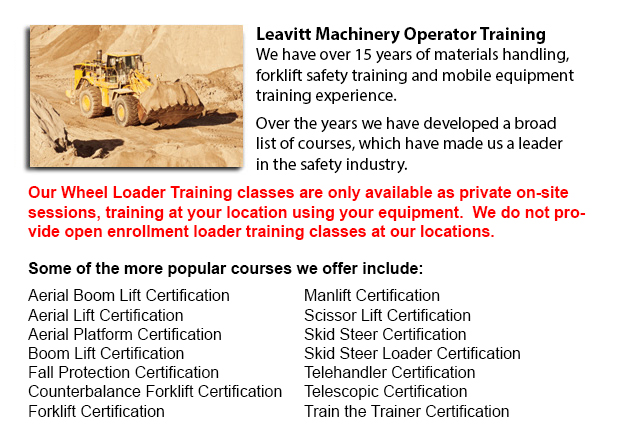
Toronto Wheel Loader Operator Training - Cranes are industrial equipment which utilize pulleys or levers so as to lift substantial weights. The Romans utilized cranes in order to construct big monuments, which means these machinery have been existing for at least 2,000 years. Many Medieval churches used cranes in their creation and the Egyptian people might have used them when building the pyramids.
Modern cranes could either be complex or simple, based upon the nature of the function they are able to perform. For example, mobile cranes are somewhat simple models. A steel truss and even a telescopic boom mounts its movable platform. A system of levers or pulleys raises the boom and there is usually a hook hanging. These cranes are normally used for demolition or earthmoving by changing the hook out with another piece of equipment like a bucket or wrecking ball. Telescopic cranes have a series of hydraulic tubes which fit together to form the boom. These units could also be mobile.
Standard wheels, or particular wheels designed for a railroad track or caterpillar track enable these mobile booms to be able to navigate uneven and unpaved surfaces.
Rough terrain and truck mounted cranes are mobile also. Outriggers are placed on the truck mounted unit to be able to improve stability, while rough terrain cranes comprise a base which tends to resemble the bottom of a 4-wheel drive. These cranes are equipped so as to operate on uneven surface making them best in the construction trade for instance.
Gantry cranes are used in order to transfer and unload huge containers off of ships and trains. They are normally seen working in ports and railroads. Their bases include massive crossbeams which run on rails in order to pick up containers from a spot to another. A portainer is a special type of gantry which moves materials onto and off of ships in particular.
Important to the shipping industry, floating cranes could be attached on barges or pontoons. Being placed in water, they are perfect for use in salvaging ships, building bridges and port construction. Floating cranes can handle extremely heavy loads and containers and similar to portainers, they could likewise unload ships.
Loader cranes comprise hydraulic powered booms that are fitted onto trailers to load goods onto a trailer. The jointed parts of the boom can be folded down if the machinery is not in being used. This type of crane can be also considered telescopic as a section of the boom could telescope for more versatility.
Stacker cranes are often used in automated warehouses. They tend to follow an automatic retrieval system and could work through remote. These cranes are equipped along with a lift truck apparatus and can be seen in huge automated freezers, obtaining or stacking foodstuff. Utilizing this type of system enables personnel to remain out of that freezing setting.
Tower cranes, often the tallest kind, usually do not have a movable base. They have to be assembled part by part. Their base is like a long ladder with the boom at right angles to the base. These cranes specialize in the construction of tall structures and are usually affixed to the inside of the building itself throughout the construction period.
-
Toronto Wheel Loader Training
Toronto Wheel Loader Training - Normally, the different kinds of heavy equipment training are classed into 2 categories of machinery: those that have rubber tires and tracked vehicles. Tracked vehicles consist of items like for example excavators, cr... More -
Toronto Heavy Equipment Operator Training
Toronto Heavy Equipment Operator Training - Heavy equipment operator training facilities that provide good standards in the business, providing field performance tasks and added machinery training are really sought after training features. Students a... More -
Toronto Manlift Operator Certification
Toronto Manlift Operator Certification - We provide an aerial lift and scissor platform certification and training to empower the trainee with the general understanding and knowledge of the safe and efficient use of "Power Operated Mobile Work Platfo... More -
Toronto Aerial Boom Lift Ticket
Toronto Aerial Boom Lift Ticket - Aerial lifts can be utilized to accomplish a lot of unique duties done in hard to reach aerial spaces. Some of the odd jobs associated with this type of jack include performing regular preservation on structures with... More -
Toronto Heavy Equipment License
Toronto Heavy Equipment License - Obtaining a heavy equipment license is mandatory in order to operate these big industrial machinery. Certification could be acquired through a vocational school or private training. The license would enable the drive... More -
Skid Steer Loader Training in Toronto
A skid-steer loader is an engine powered equipment which consists of a small and rigid frame. It is outfitted together with lift arms that are utilized to connect to a large variety of labor saving tools and attachments. Typically, skid-steer loaders... More -
Toronto Aerial Lift Certification
Toronto Aerial Lift Certification - Aerial Lift Certification is for individuals who requires an in-depth understanding of aerial lift safety. Inspectors and operators, supervisors, maintenance workers and construction craftsmen should perform a cert... More -
Toronto Boom Lift Training
Toronto Boom Lift Training - Elevated work platforms, also called aerial platforms, allow workers to carry out tasks at heights which would otherwise be not reachable. There are different kinds of lifts intended for various site conditions and applic... More

Forklift Certification Toronto
TOLL FREE: 1-888-254-6157
Toronto, Ontario
forkliftcertificationtoronto.com
Email Us
About Us


